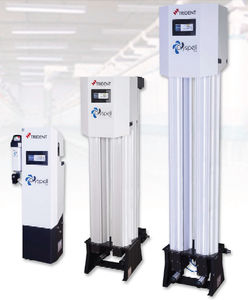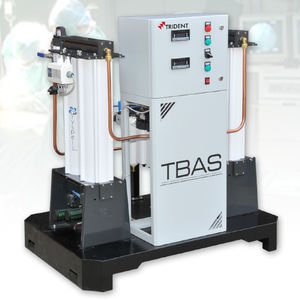
- Industrial machines and equipment
- Furnace and Heat Treatments
- Desiccant dryer
- Trident Pneumatics Pvt Ltd
- Company
- Products
- Catalogs
- News & Trends
- Exhibitions
Desiccant dryer DP seriescontinuousgasair


Add to favorites
Compare this product
Characteristics
- Technology
- desiccant
- Batch/continuous
- continuous
- Applications
- gas, air
Description
All about heatless
air and gas dryers
A majority of the Industrial Compressed Air Systems and different other applications of gas and/or air dryers involve the use of Heatless Compressed Air and/or Gas Dryer systems. High Pressure Gas and Air Drying Systems also involve the use of these compressed air and gas dryers in many of their applications. Trident Pneumatics excels in heatless air dryer manufacturing
HOW IT FUNCTIONS?
The simplest form of a desiccant kind of gas or air dryer is the heatless compressed one. It can achieve a dewpoint of -40°C for the compressed air systems as well as the other applications of gas and/or air dryers. After passing through the pre-filter, the wet incoming compressed air passes thorugh the assembly of the slide piston. Next, this air is directed towards the first chamber wherein it travels upwards through the desiccant bed consisting of activated alumina or molecular sieves. This causes it to dry up due to the adsorption effect of the bed. The dry compressed air coming out of the first chamber now travels through the assembly of check valves hence paving its way through the alter-filter and thereby to the area of application or work. The desiccant in the second chamber that had been wetted in the previous cycle regenerates simultaneously as the compressed air dries in the first chamber. The purge valve depressurizes the second chamber down to the atmospheric pressure in the downward direction. Meanwhile, a portion of the dry compressed air flushes the desorbed moisture out by passing through the needle valve or orifice plate through the desiccant.
Catalogs
Other Trident Pneumatics Pvt Ltd products
COMPRESSED AIR DRYER PRODUCTS
Related Searches
- Drying system
- In-line dryer
- Compressed air dryer
- Refrigerated compressed air dryer
- Adsorption compressed air dryer
- Compact compressed air dryer
- Air drying system
- Single-stage compressed air dryer
- Desiccant dryer
- High-quality compressed air dryer
- Gas dryer
- Air-cooled compressed air dryer
- Membrane compressed air dryer
- High-performance compressed air dryer
- High-pressure compressed air dryer
- Blower purge compressed air dryer
- High-temperature compressed air dryer
- Low-pressure compressed air dryer
- Medical compressed air dryer
- Adsorption with heat compressed air dryer
*Prices are pre-tax. They exclude delivery charges and customs duties and do not include additional charges for installation or activation options. Prices are indicative only and may vary by country, with changes to the cost of raw materials and exchange rates.








